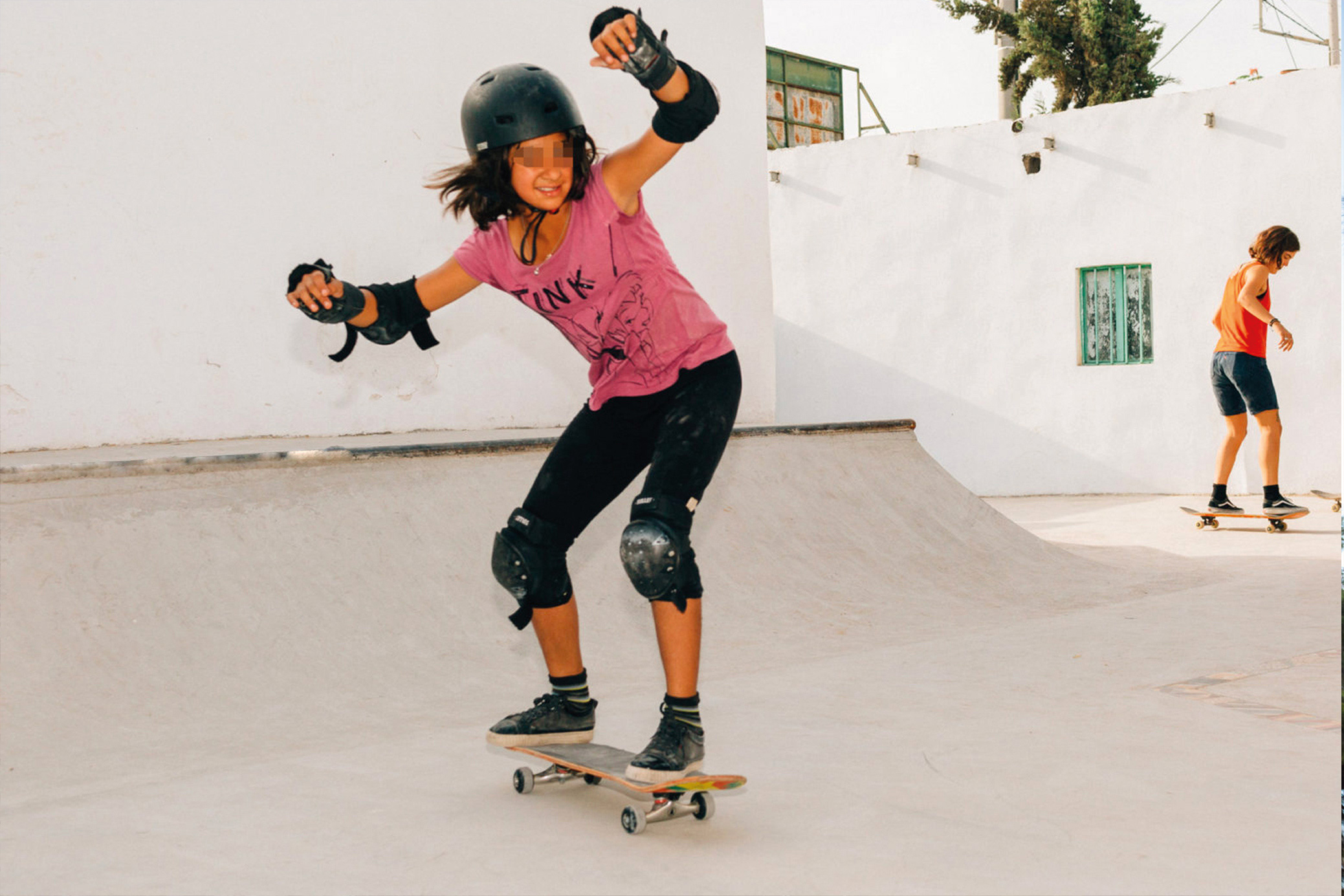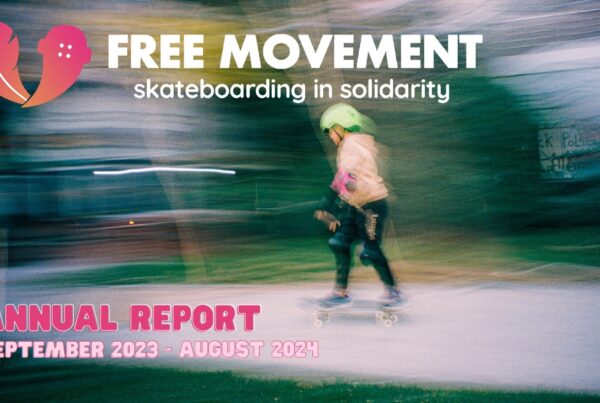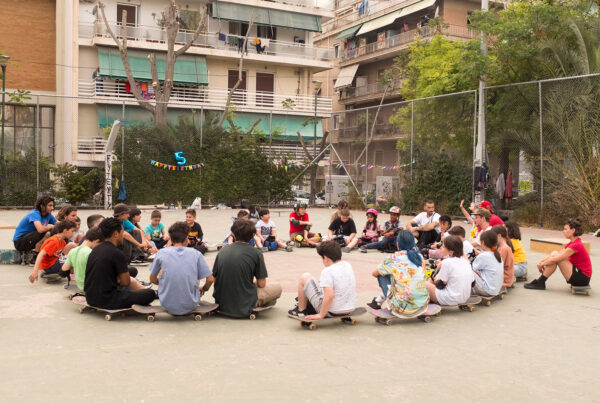Many of the young people we teach have experienced prolonged periods of trauma and stress, which can have a lasting effect on behaviour and cause severe changes in the developing brain. Current research shows that engaging in regular physical activity can stimulate brain function, which, in turn, helps to regulate stress and improve mental health. Skateboarding in particular can be highly soothing due to its vast sensory stimuli and social nature; most importantly, in how it teaches tenacity and resilience.
It is hard to put your finger on what exactly skateboarding makes you feel. Whilst setting up Free Movement Skateboarding, we spoke a lot about the determination and resilience that can be developed whilst learning to skateboard. At that point, we were of course speaking from our own experiences growing up skateboarding and from the time we spent teaching skateboarding in Palestine with SkatePal. Personally, I know I’ve gained a load of confidence from skating—I know it gives me energy, self-esteem, I know it makes me feel powerful—but what is actually going on inside my body, inside my brain, that makes me feel that way? In the previous article, I spoke briefly about the social elements of skateboarding—how it can open up your surroundings in new and exciting ways, the freedom and creative expression that comes with it; inviting exploration and adventure. Now, I will look more closely into the relationship between physical activity and brain functioning—specifically, what changes are happening inside the brain whilst exercising that can stimulate positive steps towards a calm and regulated mental state.
Many recent studies have shown how exercising for as little as twenty minutes a day can significantly improve overall brain functioning and reduce the negative effects of stress. Just like exercise triggers the growth of muscles cells, it also activates synaptic connections within the brain, aids the bodily release of many different hormones, and ‘provides a nourishing environment for the growth of brain cells.’ The potential of neuroplasticity is fascinating to note—physical activity can boost many positive changes within our brains, affecting it not just functionally, but also structurally. We can actually ‘rewire’ our brains by ensuring that we are active and stimulated on a frequent basis.

There are four major parts of the brain: the brainstem, diencephalon, the limbic system, and the neocortex. Brain development occurs from the bottom-up—starting at the brainstem, where information is initially processed, through the diencephalon and the limbic system, up to the neocortex. The diencephalon is responsible for self-regulation and the limbic system is the centre of emotions, attachment and relationships. The hippocampus is an important part of the limbic system—it is responsible for the formation of new memories and is highly networked within the brain; stimulating nerve growth and gene activation. The neocortex is the region which deals with abstract reasoning and enables you to learn new skills. Critically, the neocortex can only perform properly when the lower domains of the brain are regulated and functioning well.
Now that we’ve been teaching workshops in Athens for just over two years, we are able to see the tangible impact skateboarding has had on the lives of hundreds of young people. We can see that we are improving the integration of refugee and migrant communities into the local Athenian community. We witness the young people we teach mastering new skills on a weekly basis, overcoming fears and exceeding their own expectations of themselves. We receive positive feedback from our partner organisations about increased focus and attention across the board from young people who previously struggled to concentrate on the task at hand. However, it wasn’t until we saw ‘Push to Heal’ last year that we started to understand the internal processes taking place within the body which have the potential to instigate these positive changes.
In the film, published by Hull Services and the Child Trauma Academy, Joel Pippus (Youth Care Counsellor, Hull Services) and Dr. Emily Wang (Director of Trauma Informed Services, Hull Services) share their fascinating research into how skateboarding fits within their neurosequential model of therapeutic care; which is designed for working with children affected by trauma. They have found that skateboarding, due to its social aspects and high sensory stimuli, can help to create regulation in the lower domains of the brain (the brainstem and the diencephalon), which in turn effects positive changes within the higher regions of the brain (the limbic system and the neocortex); enabling development that can be beneficial for people suffering from dysregulation due to trauma and prolonged stress.
‘Time spent on a skateboard by young people can help their brains to heal from past trauma. It can actually move the development of the brain into a more positive trajectory, from the brain stem right up to the neocortex.’ (Dr. Emily Wang)
Skateboarding itself incorporates many different sensory stimuli—vibrations, sounds, motion, speed, the wind against your face—and demands multiple skills such as balance, strength, coordination and agility. Couple these with the social aspects of skating within a skatepark or in a taught session, and you also have to think about etiquette, social keys, body language and communication. All of this accumulates as an all-encompassing experience that is highly regulating for the body and brain. This information is processed initially in the brainstem and the various different aspects mean that the diencephalon, limbic system and the neocortex are all receiving positive and soothing stimuli. By allowing the brain to function in this way, you are creating the perfect environment for self-regulation; enabling yourself to learn new skills and manage complex emotions.

As I outlined in the first article in this series, trauma can severely damage the communication routes within the brain—making it extremely difficult for an individual to voice their inner-experiences, which can often lead to further isolation and frustration. In our sessions, we have seen that implementing dynamic group exercises is a really good way to encourage communication and social interaction. This can be as simple as counting together loudly whilst completing the warm-up stretches and cheering each other on when someone is learning a new trick. This communication is also a key factor in establishing connections between people and creating a sense of belongingness, which is so crucial for maintaining healthy relationships. With these social factors working in unison with the neural connections mentioned above, we can see how skateboarding regularly in a supportive environment can begin to re-establish communication, relationships and self-regulation; helping to regulate stress and improve mental health.
You can read the previous article in this series here: Can skateboarding regularly help to improve well-being and mental health?
You can watch ‘Push to Heal’ here: Push to Heal
Words & Photographs: Ruby Mateja







